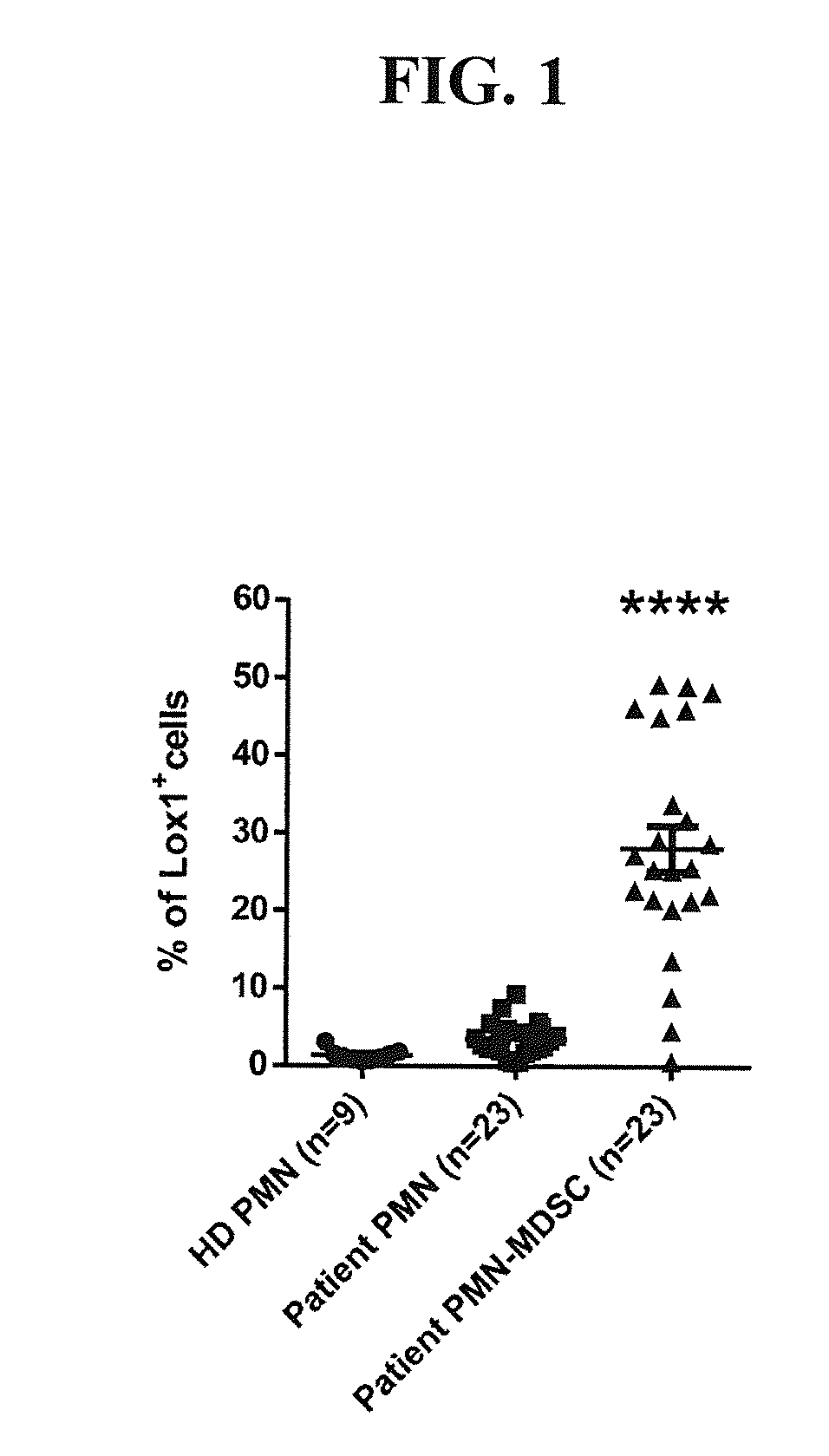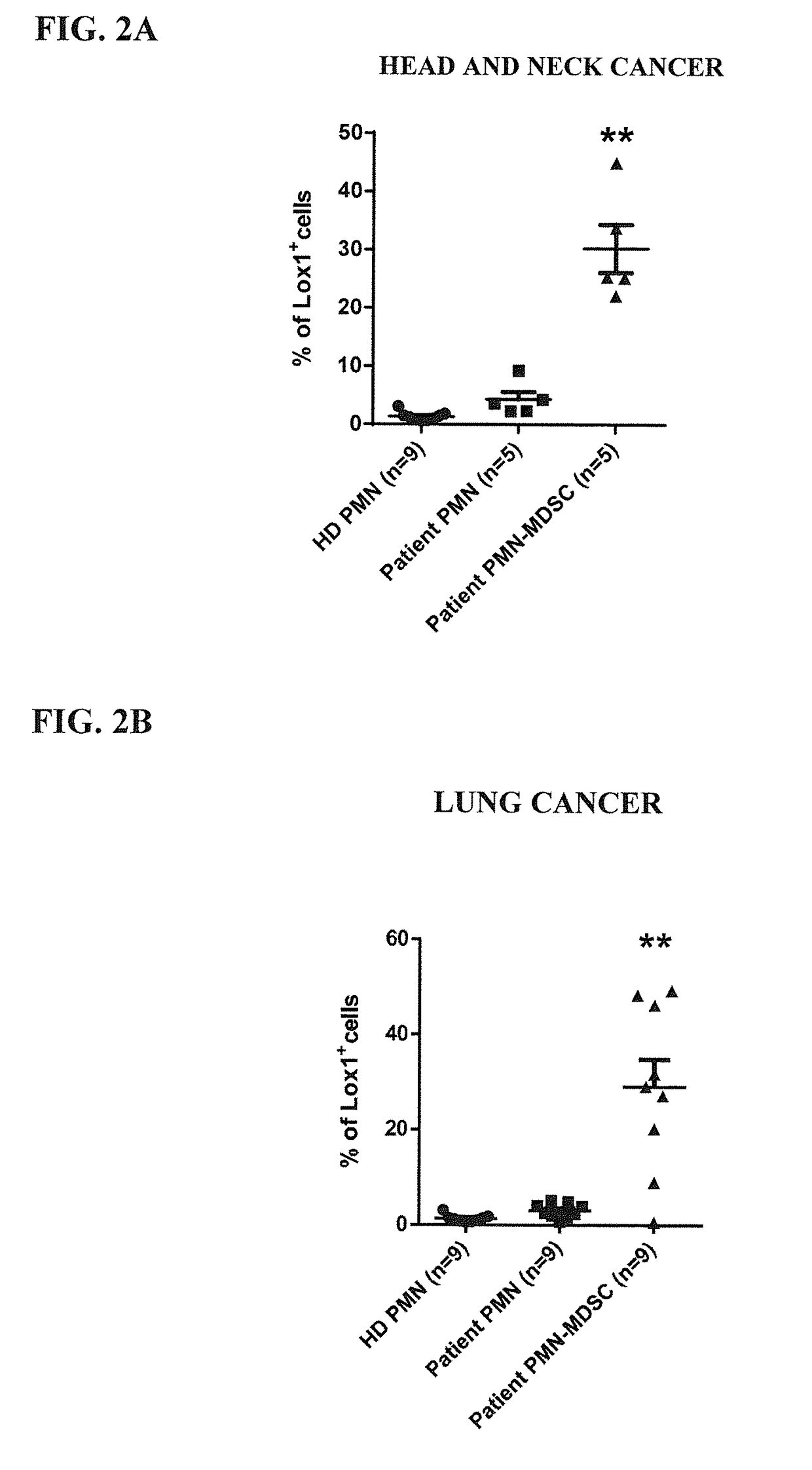Methods for monitoring polymorphonuclear myeloid derived suppressor cells, and compositions and methods of treatment of cancer
a technology of suppressor cells and polymorphonuclear myeloids, applied in the direction of antibody medical ingredients, instruments, peptides, etc., can solve the problems of not being able to distinguish between pmn-mdsc and pmn in tumor tissues, hammering the progress in understanding the biology and clinical significance of these cells, etc., to reduce or inhibit the er stress response, reduce or inhibit the expression of lox-1
- Summary
- Abstract
- Description
- Claims
- Application Information
AI Technical Summary
Benefits of technology
Problems solved by technology
Method used
Image
Examples
example 1
ng Discriminatory Markers
[0152]In order to identify specific markers discriminating between these two populations, we performed genome—wide microarrays (Human HT-12 v4 expression Beadchip, Illumina) to compare the gene expression profiles between PMN-MDSC and PMN from the same cancer patients (7 patients) as well as age matching healthy donors (4 donors). All samples of peripheral blood (PB) were collected from patients at the Helen F. Graham Cancer Center and were analyzed within 3 hours of collection. PMN-MDSCs were evaluated in mononuclear fraction of PB after ficoll density gradient. PMN were evaluated from the cell fraction remaining after removal of mononuclear cells. Cells were resuspended in PBS and loaded on a step density gradient (Percoll 63% on top of Percoll 72%) to separate PMNs in a monolayer between the two Percoll phases. In an attempt to minimize the number of potential candidates and to identify true marker of PMN-MDSC, we analyzed the gene expression profiles of ...
example 2
g Validity of Lox-1 as a Biomarker
[0154]To confirm the validity of LOX-1 as a potential biomarker of PMN-MDSC, we analyzed the expression of this receptor by flow cytometry using an anti-LOX-1 monoclonal antibody (clone 15C4; Biolegend Inc., San Diego, Calif.) in blood samples from patients with 4 different types of cancer: head and neck, breast, non-small lung, or colon cancer.
[0155]We first analyzed the expression of LOX-1 using the classical definitions of PMN-MDSC (CD11b+CD14−CD15+ and CD33+ from the low density mononuclear cells fraction) and PMN (cells with the same phenotype from high density fraction). The results of this experiment are reported graphically when healthy donors (HD) were compared with all cancer patients in FIG. 1. About 30% of the PMN-MDSC from all cancer patients (n=23) was found to express LOX-1 on their surface compared to less than 3% of the PMN from matching patients or about 1% from PMN from healthy donor (n=9) (p<0.001).
[0156]The results of this exper...
example 3
of Whole Blood Samples
[0158]We also performed an analysis of unseparated whole blood samples. As shown in FIGS. 4A and 4C, as expected, about 1% or less of the CD11b+CD14−CD15+ and CD33+ PMN from healthy donors expressed LOX-1 on their surface. However, in samples from cancer patients (both head and neck and lung cancer patients), almost 5% of the PMN types of cells exhibit a positive staining for LOX-1 (≈2.3% of the total leukocytes) strongly supporting the designation of LOX-1 as a specific marker of PMN-MDSC. These results were confirmed by analyzing the disease separately, as reported in FIGS. 4B and 4D.
PUM
| Property | Measurement | Unit |
|---|---|---|
| concentration | aaaaa | aaaaa |
| pH | aaaaa | aaaaa |
| ER stress response | aaaaa | aaaaa |
Abstract
Description
Claims
Application Information
 Login to View More
Login to View More - R&D
- Intellectual Property
- Life Sciences
- Materials
- Tech Scout
- Unparalleled Data Quality
- Higher Quality Content
- 60% Fewer Hallucinations
Browse by: Latest US Patents, China's latest patents, Technical Efficacy Thesaurus, Application Domain, Technology Topic, Popular Technical Reports.
© 2025 PatSnap. All rights reserved.Legal|Privacy policy|Modern Slavery Act Transparency Statement|Sitemap|About US| Contact US: help@patsnap.com



